Background
During the 1990s, disk bandwidth, processor speed and main memory capacity were increasing at a rapid rate.
With increase in memory capacity, more items could now be cached in memory for reads. As a result, read workloads were mostly absorbed by the operating system page cache. However, disk seek times were still high due to the seek and rotational latency of physical R/W head in a spinning disk. A spinning disk needs to move to a given track and sector to write the data. In the case of random I/O, with frequent read and write operations, the movement of physical disk head becomes more than the time it takes to write the data. From the LFS paper, traditional file systems utilizing a spinning disk, spends only 5-10% of disk’s raw bandwidth whereas LFS permits about 65-75% in writing a new data (rest is for compaction). Traditional file systems write data at multiple places: the data block, recovery log and in-place updates to any metadata. The only bottleneck in file systems now, were during writes. As a result, there was a need to reduce writes and do less random I/O in file systems. LFS came with the idea that why not write everythng in a single log (even the metadata) and treat that as a single source of truth.
Log structured file systems treat your whole disk as a log. Data blocks are written to disk in an append only manner along with their metadata (inodes). Before appending them to disk, the writes are buffered in memory to reduce the overhead of disk seeks on every write. On reaching a certain size, they are then appended to disk as a segment (64kB-1MB). A segment contains data blocks containing changes to multitude of files along with their inodes. At the same time on every write, an inode map (imap) is also updated to point to the newly written inode number. The imap is also then appended to the log on every such write so it’s a just single seek away.
We’re not going too deep on LFS, but you get the idea. LSM Tree steals the idea of append only style updates in a log file and write buffering and has been adopted for use as a storage backend for a lot of write intensive key value database systems. Now that we know of their existence, let’s look at them more closely.
Log-structured merge-trees (LSM trees)
A log-structured merge-tree (LSM tree) is a data structure typically used when dealing with write-heavy workloads. The write path is optimized by only performing sequential writes.
- LSM trees are the core data structure behind many modern NoSQL Databases e.g. BigTable, Cassandra, HBase, RocksDB, and DynamoDB.
- LSM trees are used in data stores such as Apache AsterixDB, Bigtable, HBase, LevelDB, Apache Accumulo, SQLite4,[8] Tarantool,[9] RocksDB, WiredTiger,[10] Apache Cassandra, InfluxDB[11] and ScyllaDB.
Like other search trees, an LSM-tree contains key-value pairs. It maintains data in two or more separate components (sometimes called SSTables).
The LSM Trees use two separate structures to store data and perform optimised Reads and Writes over them.
- The first structure is smaller and stored in the memory in the form of a Red Black Tree or an AVL Tree. This structure is also known as Memtable.
- The second structure is comparatively larger and is present on the Disk, It is stored in the form of SS Tables also known as Sorted String Tables.
As data files accumulate on disk, they are organized into levels based on their size and age. The lower levels contain larger and older files, while the higher levels contain smaller and newer files. The levels are merged periodically to maintain a compact and efficient data structure, with the smallest and newest data being prioritized to ensure fast access times.
Memtables
The Memtables are maintained in the memory and every Database write is directed to this Memtable. These Memtables are generally an implementation of Tree data structure in order to maintain the keys in a sorted format. It can be a Red-Black Tree or an AVL Tree.
Writing to the Memtable
When a Write is issued to the Database it is simply written to the Memtable in the memory. Since the writes take place in the memory, the process is very fast.
Under the hood we have used a Tree Structure in order to store keys in a sorted format. Since the Tree structure used here is a Self Balancing tree, it guarantees the Writes and Reads to be performed within Logarithmic time.
We can use AVL Tree for this implementation which supports addition of nodes in logarithmic time and maintains them in a sorted order. They also allow reading all the nodes in a sorted format in linear time. This advantage of the AVL Tree will help us in future when we flush the data to the disk from the memory.
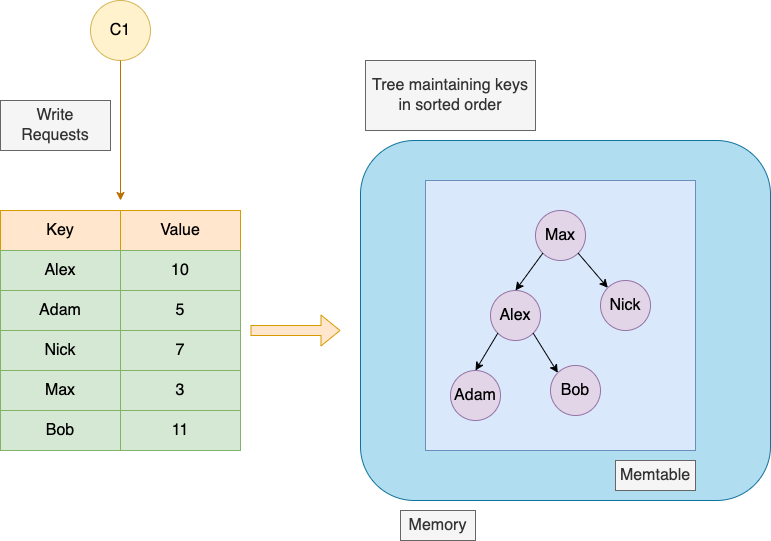
SSTables
LSM trees are persisted to disk using a Sorted Strings Table (SSTable) format. As indicated by the name, SSTables are a format for storing key-value pairs in which the keys are in sorted order. Each key only appears once within each merged segment file (the compaction process already ensures that
An SSTable will consist of multiple sorted files called segments.
A simple example could look like this:
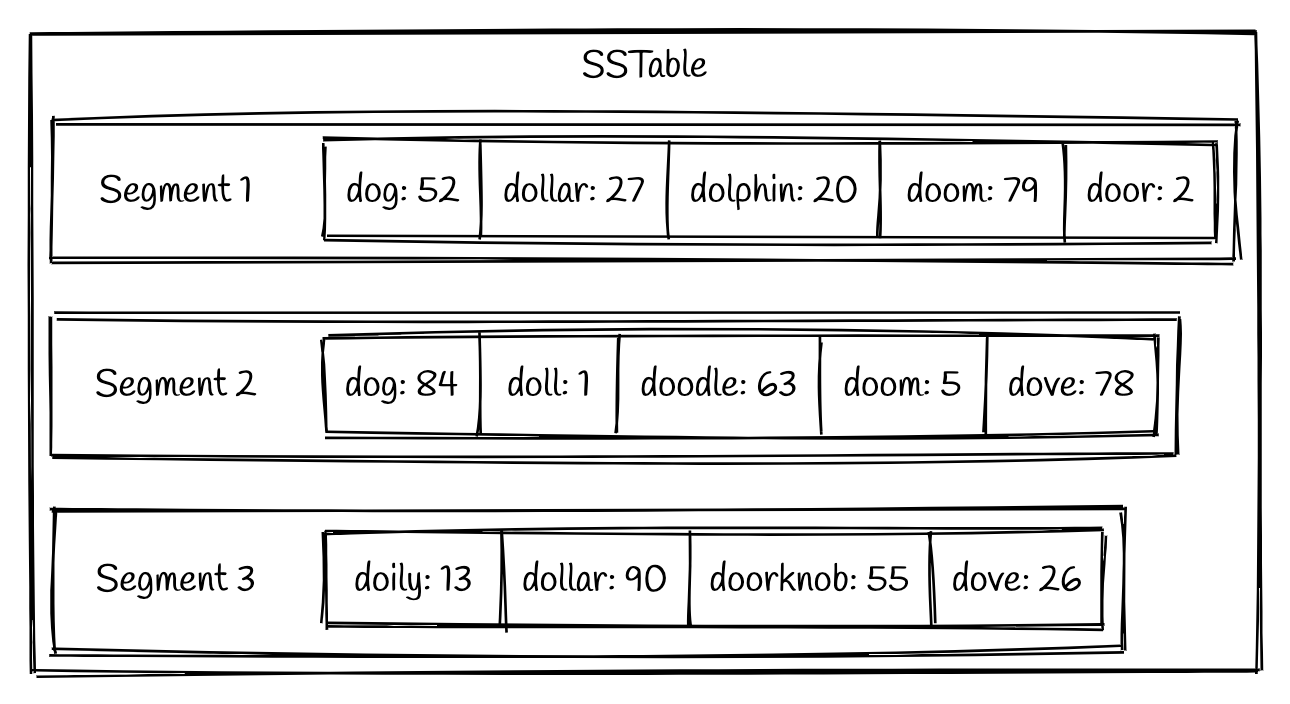
Advantages
SSTables have several big advantages over log segments with hash indexes:
-
Merging segments is simple and efficient, even if the files are bigger than the available memory. The approach is like the one used in the mergesort algorithm and is illustrated below: you start reading the input files side by side, look at the first key in each file, copy the lowest key (according to the sort order) to the output file, and repeat. This produces a new merged segment file, also sorted by key.
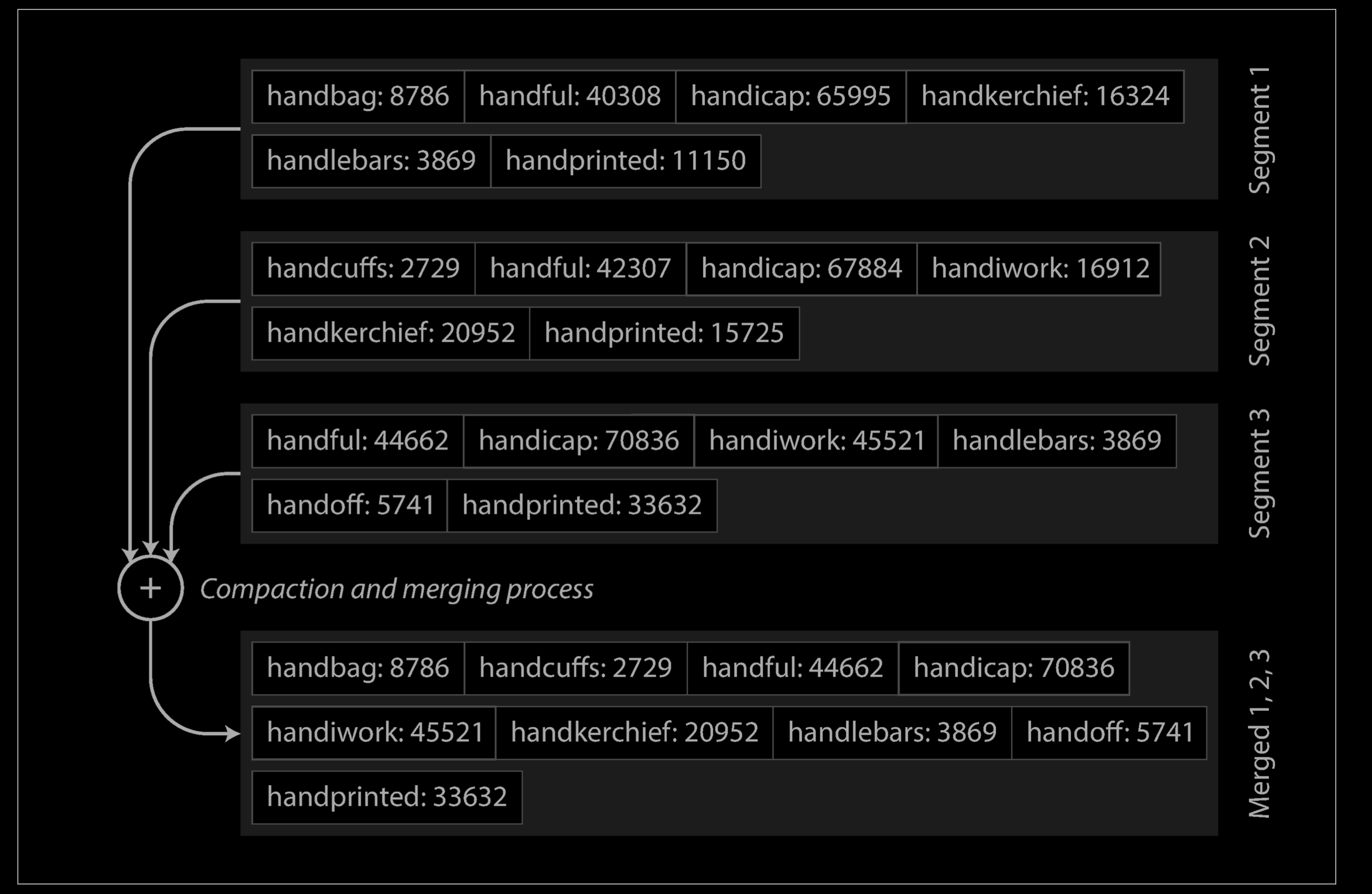
What if the same key appears in several input segments? Remember that each segment contains all the values written to the database during some period of time. This means that all the values in one input segment must be more recent than all the values in the other segment (assuming that we always merge adjacent segments). When multiple segments contain the same key, we can keep the value from the most recent segment and discard the values in older segments.
-
In order to find a particular key in the file, you no longer need to keep an index of all the keys in memory. See below for an example: say you’re looking for the key
handiwork, but you don’t know the exact offset of that key in the segment file. However, you do know the offsets for the keyshandbagandhandsome, and because of the sorting you know thathandiworkmust appear between those two. This means you can jump to the offset forhandbagand scan from there until you find handiwork (or not, if the key is not present in the file).You still need an in-memory index to tell you the offsets for some of the keys, but it can be sparse: one key for every few kilobytes of segment file is sufficient, because a few kilobytes can be scanned very quickly.
You still need an in-memory index to tell you the offsets for some of the keys, but it can be sparse(稀疏的): one key for every few kilobytes of segment file is sufficient, because a few kilobytes can be scanned very quickly.
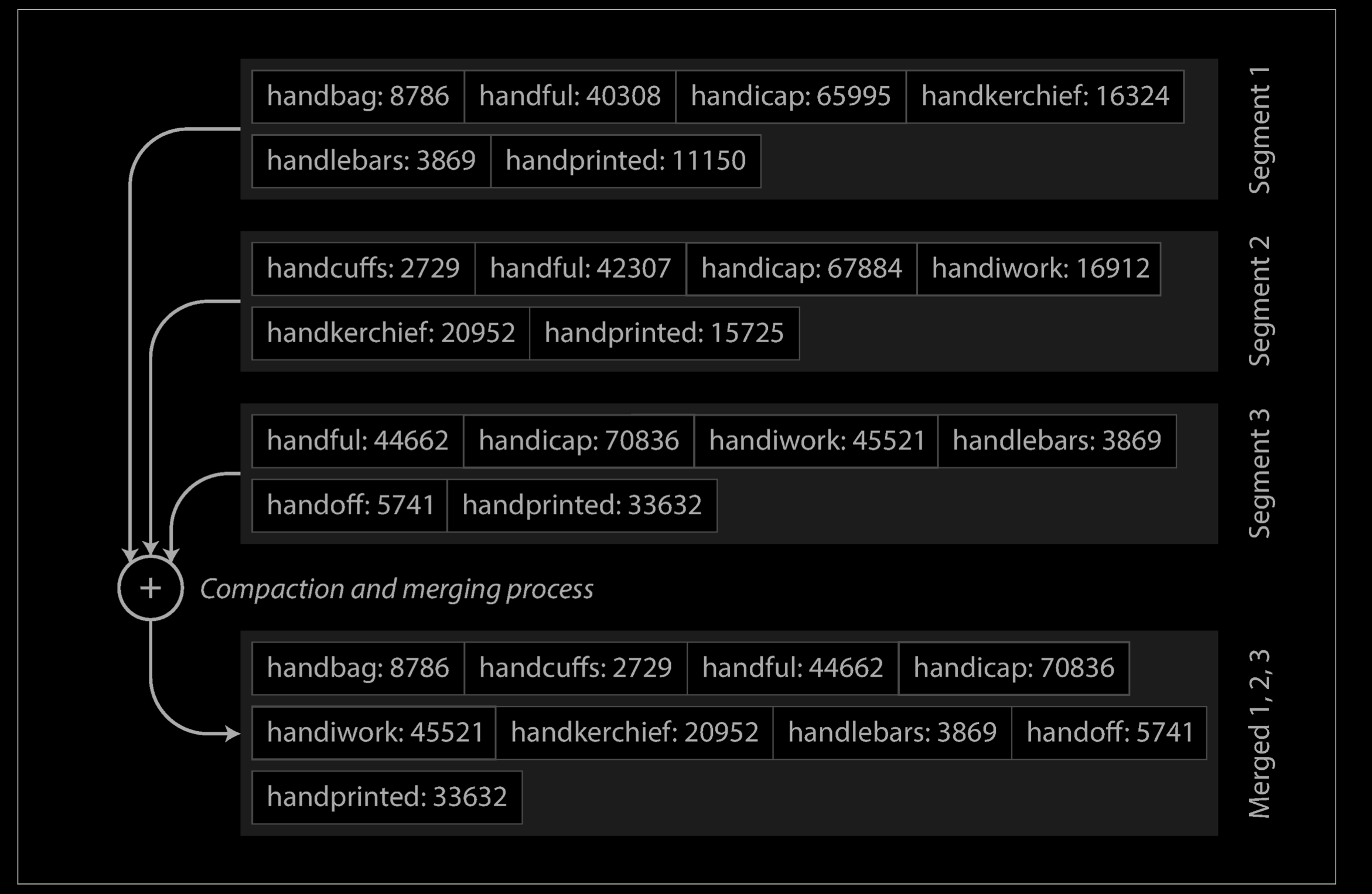
- Since read requests need to scan over several key-value pairs in the requested range anyway, it is possible to group those records into a block and compress it before writing it to disk (indicated by the shaded area above. Each entry of the sparse in-memory index then points at the start of a compressed block. Besides saving disk space, compression also reduces the I/O bandwidth use.
Compaction
Compaction strategies
A compaction strategy must choose which files to compact, and when to compact them. There are a lot of different compaction strategies that impact the read/write performance and the space utilization in the LSM Tree. Some of the popular compaction strategies that are used in production systems are:
- Size-tiered compaction stratey (STCS)
- The idea behind STCS is to compact small
SSTables into mediumSSTables when the LSM-tree has enough smallSSTables and compact mediumSSTables into largeSSTables when LSM-tree has enough mediumSSTables. - This is write optimized compaction strategy and is the default one used in ScyllaDB and Cassandra. But it has high space amplification, so other compaction strategies such as leveled compaction were developed.
- The idea behind STCS is to compact small
- Leveled compaction strategy (LBCS)
- The idea of LBCS is to organize data into levels and each level contains one sorted run. Once a level accumulates enough data, some of the data at this level will be compacted to the higher level.
- Improves over size-tiered and reduces read amplification as well as space amplification. This is the default in LevelDB.
- Time windowed compaction strategy - Used for time series databases. In this strategy, a time window is used post which compaction is triggered.
The above are not the only strategies and various systems have developed their own such as the hybrid compaction strategy in ScyllaDB.
Over time, this system will accumulate more segment files as it continues to run. These segment files need to be cleaned up and maintained in order to prevent the number of segment files from getting out of hand. This is the responsibility of a process called compaction. Compaction is a background process that is continuously combining old segments together into newer segments.
Suppose we have three segments of SS Tables with us over the disk. The merging process will look similar to the process we follow in the Merge-Sort Algorithm to merge two sorted arrays. The idea is to keep a pointer at the start of each Table segment and pick the smallest key and add it to the resulting segment and move that pointer one step ahead. We keep iterating over this process until all the key value pairs in all segments are pushed to the resulting segment.
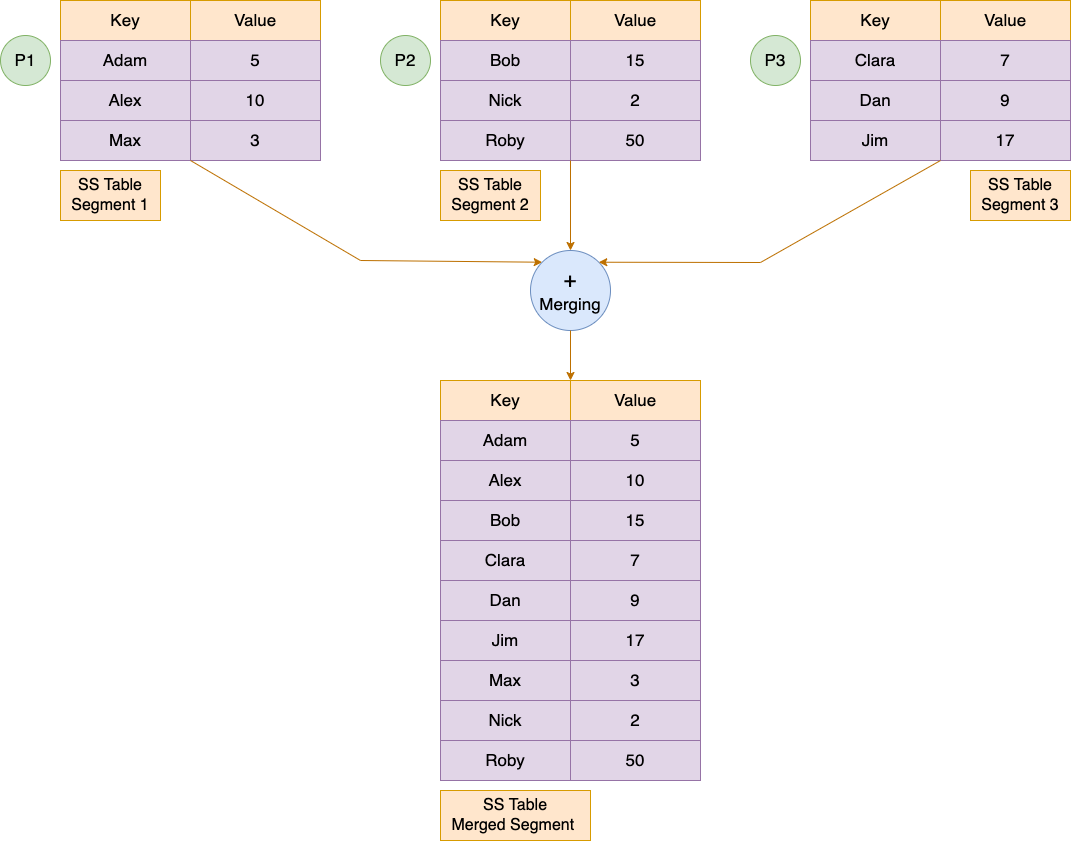
While Merging we also take care of the duplicate keys. If the same key appears in multiple segments then we keep the key from the most recent segment and discard the keys from the older segments. This process is known as Compaction.
Maintaining all the keys in a sorted order in every segment helps in the merging process. It helps generate a merged sorted-ordered segment in linear time. This is a big advantage over the Hash-based data structures.
Reads
So how do we find a value in our SSTable? A naive approach would be to scan the segments for the desired key. We would start with the newest segment and work our way back to the oldest segment until we find the key that we’re looking for. This would mean that we are able to retrieve keys that were recently written more quickly. A simple optimization is to keep an in-memory sparse index.

We can use this index to quickly find the offsets for values that would come before and after the key we want. Now we only have to scan a small portion of each segment file based on those bounds. For example, let’s consider a scenario where we want to look up the key dollar in the segment above. We can perform a binary search on our sparse index to find that dollar comes between dog and downgrade. Now we only need to scan from offset 17208 to 19504 in order to find the value (or determine it is missing).
This is a nice improvement, but what about looking up records that do not exist? We will still end up looping over all segment files and fail to find the key in each segment. This is something that a bloom filter can help us out with. A bloom filter is a space-efficient data structure that can tell us if a value is missing from our data. We can add entries to a bloom filter as they are written and check it at the beginning of reads in order to efficiently respond to requests for missing data.
SSTable enchancements
In practical implementations, SSTable files are also augmented with a SSTable summary and an index file which acts as a first point of contact when reading data from an SSTable. In this case, the SSTable is split into data files, an index file and a summary file (used in Casssandra and ScyllaDB).
SSTable data file
The SSTable data files are usually encoded in a specific format with any required metadata and the key value entries are stored in chunks called blocks. These blocks may also be compressed to save on disk space. Different levels may use different compression algorithms. They also employ checksums at each block to ensure data integrity.
SSTable index file
The index file lists the keys in the data file in order, giving for each key its position in the data file.
SSTable summary file
The SSTable summary file is held in memory and provides a sample of keys for fast lookup in the index file. Think of it like an index for the SSTable index file. To search for a specific key, the summary file is consulted first to find a short range of position in which the key can be found and the loads up that specific offset in memory.
Operations
Constructing and maintaining SSTables
Maintaining a sorted structure on disk is possible (see “B-Trees” on page 79), but maintaining it in memory is much easier. There are plenty of well-known tree data structures that you can use, such as red-black trees or AVL trees [2]. With these data structures, you can insert keys in any order and read them back in sorted order.
We can now make our storage engine work as follows:
- When a write comes in, add it to an in-memory balanced tree data structure (for example, a red-black tree). This in-memory tree is sometimes called a memtable.
- When the memtable gets bigger than some threshold—typically a few megabytes —write it out to disk as an SSTable file. This can be done efficiently because the tree already maintains the key-value pairs sorted by key. The new SSTable file becomes the most recent segment of the database. While the SSTable is being written out to disk, writes can continue to a new memtable instance.
- In order to serve a read request, first try to find the key in the memtable, then in the most recent on-disk segment, then in the next-older segment, etc.
- From time to time, run a merging and compaction process in the background to combine segment files and to discard overwritten or deleted values.
Writing Data
Recall that LSM trees only perform sequential writes. You may be wondering how we sequentially write our data in a sorted format when values may be written in any order. This is solved by using an in-memory tree structure. This is frequently referred to as a memtable, but the underlying data structure is generally some form of a sorted tree like a red-black tree. As writes come in, the data is added to this red-black tree.
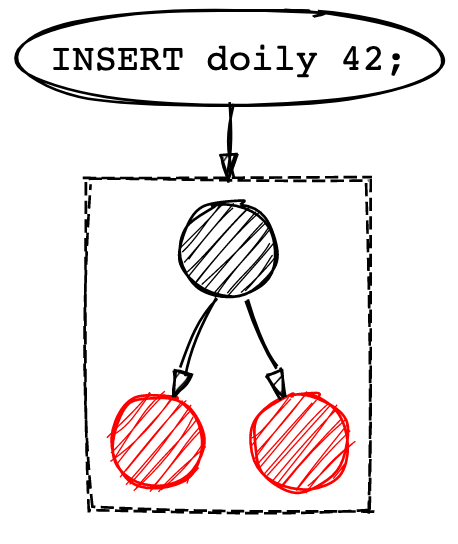
Our writes get stored in this red-black tree until the tree reaches a predefined size. Once the red-black tree has enough entries, it is flushed to disk as a segment on disk in sorted order. This allows us to write the segment file as a single sequential write even though the inserts may occur in any order.
In practical implementations, the writes are also preceded by appending the entry to a Write Ahead Log (WAL) file to protect from a crash and ensure durability. In cases when the database crashes while still holding key values in Memtable, a WAL enables one to re-build and recover uncommitted entries back in the Memtable on the next restart. On reaching the Memtable threshold, the WAL is also flushed and is replaced with a new one.
The memtables are nothing but a self balancing tree data structure that maintains the keys in a sorted order. Hence it’s very easy to iterate over the keys in a sorted order. The keys are read in a sorted order from the memtable and are further stored on the Disk.
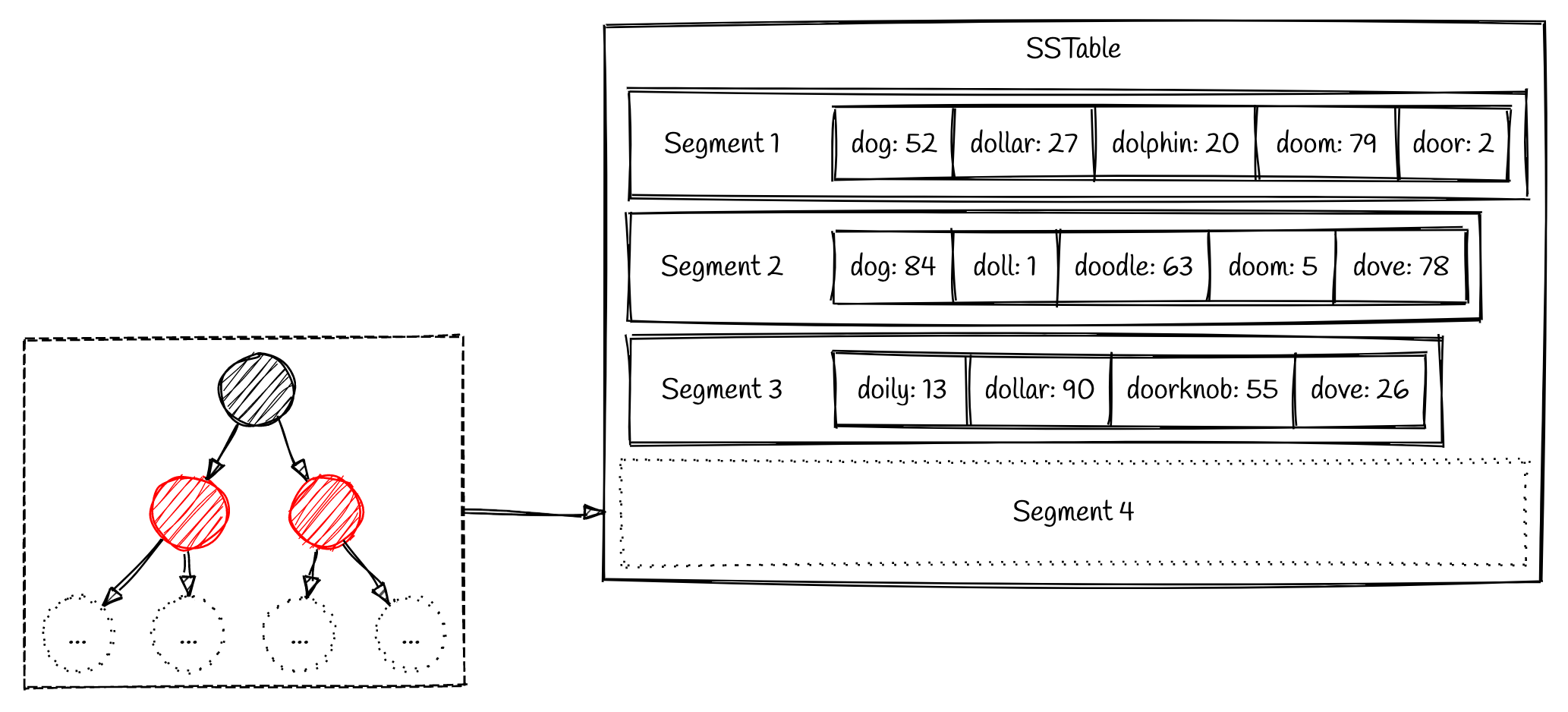
On the Disk, the data is stored in the form of the SS Tables also known as Sorted String Tables. Our Database keeps flushing the key-value pairs (in sorted order) to the disk once the size of the memtable reaches the threshold limit.
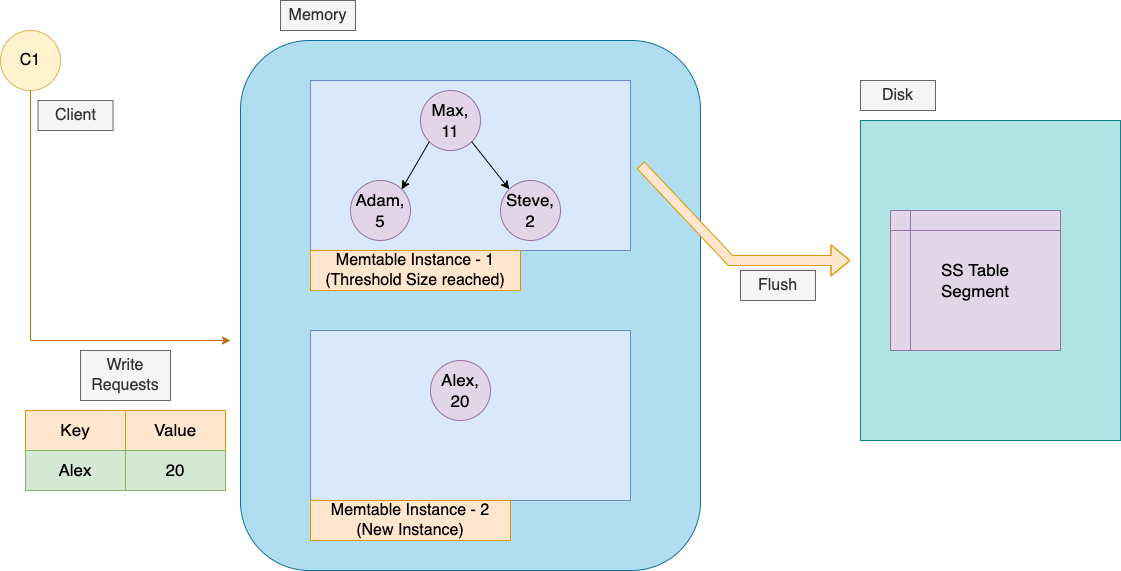
Reading Data
When a Read is performed over the database then we look for the Key in the Memtable (memory) first. Once the Key is not found in the Memtable then it is looked in the SS Table (on the disk).
We are not required to look into every key inside the SS Table to read the value of the searched key. Instead we can maintain a sparse in-memory index table to optimise this. We can store some keys with their memory location in this table. Say for every 1000 key-value pair block, we can store the first key of that block along with its memory address in the in-memory sparse index table.
Now when the read request comes up, we can precisely determine the block in which that key can be found by looking into the sparse in-memory index table. After that we can scan all the entries of that block to return the value of the key. Since each block contains a small amount of key-value pairs, it is easy to scan the entire block until we find the key we are searching for.
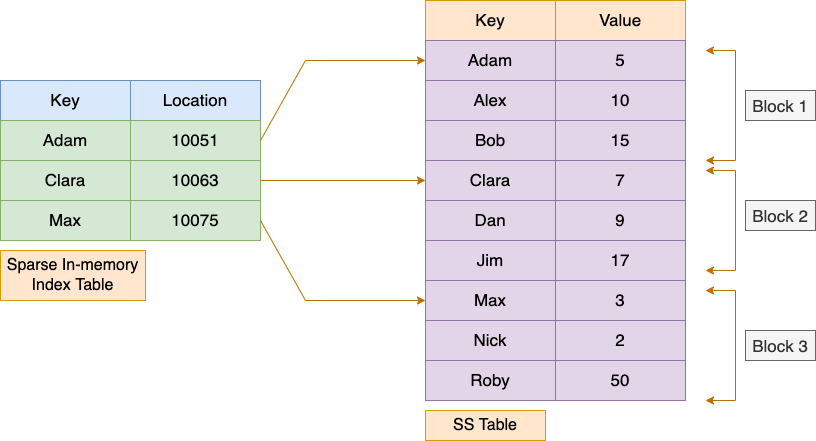
Since we are keeping only the selected keys in the in-memory index, they all can be fit into the Memory. This helps in optimising our Database Read requests.
We can still ask why we are not using Binary Search to look for a key in the SS Table block, since it already maintains the entry sorted by keys. Generally the values do not have a fixed size and hence it is difficult to tell where one record ends and the next one starts. Hence we naively perform a Linear-Search over the block to look for our key.
Fault Tolerance in Memtables
Since we are performing the writes in the memory, there is one problem that comes along with it. What if the Database crashes? We will lose all the Writes which are currently present in memory (Memtable) and are not written to the Disk (SS Tables) yet.
In order to resolve this we can maintain a separate Log on disk just to store the in-memory writes. In case of failure we can easily regenerate our Memtable from the backup Log. Once the contents of the Memtable is flushed to the Disk, we can simply discard the Log.
Performance optimizations
As always, a lot of detail goes into making a storage engine perform well in practice. For example, the LSM-tree algorithm can be slow when looking up keys that do not exist in the database: you have to check the memtable, then the segments all the way back to the oldest (possibly having to read from disk for each one) before you can be sure that the key does not exist. In order to optimize this kind of access, storage engines often use additional Bloom filters.
- A Bloom filter is a memory-efficient data structure for approximating the contents of a set. It can tell you if a key does not appear in the database, and thus saves many unnecessary disk reads for nonexistent keys.)
Drawbacks of LSM Trees
Any technology introduced, brings with it its own set of tradeoffs. LSM Tree is no different. The main disadvantage of LSM Tree is the cost of compaction which affects read and write performance. Compaction is the most resource intensive phase of LSM Tree due to compression/decompression of data, copying and comparision of keys involved in the process. A chosen compaction strategy must try to minimize read amplification, write amplification and space amplification. Another drawback of LSM Tree is the extra space required to perform compaction. This is certainly visible in size tiered compaction strategy and so other compaction strategies like leveled compaction are used. LSM Tree also makes reads slow in the worst case. Due to the append only nature, reads will have to search in SSTable at the lowest level. There’s file I/O involved in seeks which makes reads slow.
Despite their disadvantages, LSM Trees have been in use in quite a lot of database systems and has become the de-facto pluggable storage engine in lot of storage scenarios.
LSM Trees in the wild
LSM trees have been used in many NoSQL databases as their storage engine. They are also used as embedded databases and for any simple but robust data persistance uses cases such as search engine indexes.
One of the first projects to make use of LSM Trees was the Lucene search engine (1999). Google BigTable (2005), a distributed database also uses LSM Tree in their underlying tablet server design and is being used for holding petabytes of data for Google Crawl and analytics. It was then discovered by BigTable authors that the design of BigTable’s “tablet” (storage engine node) could be abstracted out and be used as a key value store.
Born off of that, came LevelDB (2011) by the same authors which uses LSM Tree as its underlying data structure. This gave rise to pluggable storage engines and embedded databases. Around the same time in 2007, Amazon came up with DynamoDB which uses the same underlying LSM Tree structure along with a masterless distributed database design.
Dynamo DB inspired the design of Cassandra (2008), which is an open source distributed NoSQL database. Cassandra inspired ScyllaDB (2015) and others. InfluxDB (2015), a time series database also uses LSM Tree based storage engine called Time structured merge tree.
Inspired from LevelDB, Facebook forked LevelDB and created RocksDB (2012), a more concurrent and efficient key value store that uses multi-threaded compaction to improve read and write performance. Recently Bytedance, the company behind TikTok has also released a key value store called terakdb that improves over RocksDB. Sled is another embedded key value store in Rust, that uses a hybrid architecture of B+ Trees and LSM Tree (Bw Trees). These fall under the category of embedded data stores.
Reference
- Designing Data Intensive Applications
- https://www.cs.umb.edu/~poneil/lsmtree.pdf
- https://en.wikipedia.org/wiki/Log-structured_merge-tree
- https://yetanotherdevblog.com/lsm/
- https://tikv.github.io/deep-dive-tikv/key-value-engine/B-Tree-vs-Log-Structured-Merge-Tree.html
- https://www.linkedin.com/pulse/data-structures-powering-our-database-part-2-saurav-prateek/
- http://www.benstopford.com/2015/02/14/log-structured-merge-trees/
- https://dev.to/creativcoder/what-is-a-lsm-tree-3d75
- https://lrita.github.io/images/posts/database/lsmtree-170129180333.pdf